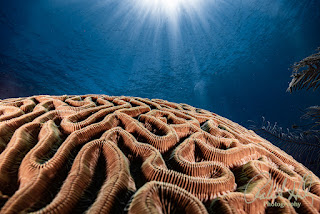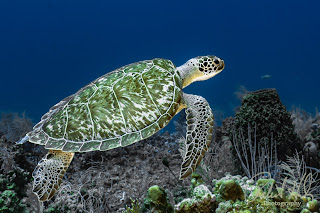Using Lightroom’s AI Object Selection for Removing Backscatter (Update)
This is an update to a previous Blog post titled "Combining Lightroom and Photoshop for Ultimate Underwater Photo Edits," posted on October 24, 2024. With all the recent advancements/updates within Lightroom, it was necessary to post this new blog.
Backscatter - the considerable nemesis of every underwater photographer. These pesky, floating particles not only disrupt the clarity of your images but also catch your strobe or video light, resulting in distracting little white spots peppered across your otherwise perfect composition. If you have spent any time shooting underwater, you are undoubtedly familiar with this frustrating phenomenon. Many photographers have experienced the urge to curse it as it ruins carefully captured moments.
Fortunately, there is a silver lining in the digital photography age. Thanks to Adobe Lightroom’s latest AI-powered tools, you can now address backscatter issues more efficiently and effectively than ever.
In an earlier blog post on backscatter removal, we relied primarily on the Spot Removal Tool (Q) and adjustment brushes to correct these nuisances. Although those methods remain effective, Lightroom Classic’s most recent updates introduce groundbreaking AI Object Selection and Adaptive Masking capabilities. These enhancements empower us to isolate subjects with surgical precision, allowing for cleaner backscatter removal while preserving the intricate details of your beautiful marine life subjects. This evolution in technology streamlines your editing process and enhances the overall quality of your underwater photography.
Let’s dive in.
What’s New in Lightroom (April 2025 Update)
Since my last post, Adobe has introduced several new and
upgraded tools that dramatically improve backscatter removal workflows:
- AI
Object Selection (with enhanced edge detection for complex shapes like
coral, fish fins, or bubbles)
- Content-Aware
Remove Tool (upgraded from the old Heal/Clone)
- Refine
Object Masking (smooths and improves subject separation)
- Masking
Groups (combine multiple AI masks for layered, targeted edits)
- AI-Powered
'Select Background' (perfect for isolating water column scatter)
- Faster
GPU-based healing for real-time previewing
Step-by-Step: Removing Backscatter with AI Tools
🔧 Tool Setup
- Shortcut
for Masking Panel: Press Shift + W
- Shortcut
for Spot Removal/Content-Aware Remove: Press Q
Here are ten Practical Examples of AI Masking to Remove Backscatter
1. Backscatter Around a Seahorse in Murky Water
- Step
1: Open the Masking Panel → Choose "Select Subject"
- Step
2: Lightroom detects the seahorse; click "Invert" to
target the background.
- Step
3: Apply the Content-Aware Remove Tool (Q) to remove spots only
from the background.
- Step
4: Optionally, reduce Texture and Clarity by -10 to -20 for a smoother
look.
🎯 Pro Tip: Use the
brush inside the mask to manually clean missed corners around tails or spines.
2. School of Fish with Backscatter in the Midwater
- Step
1: Use "Select Objects" and draw a loose box around
the fish.
- Step
2: Invert the selection to isolate the open water.
- Step
3: Activate the Remove Tool and tap-click all visible scatter
in the background.
- Step
4: Adjust the feathering to blend seamlessly with the
original light gradient.
3. Close-Up of a Nudibranch on the Reef
- Step
1: Use "Select Object" and brush roughly over the
nudibranch.
- Step
2: Use “Add New Mask > Select Background” to isolate the
surrounding substrate.
- Step
3: In the background mask, reduce Clarity slightly and heal out any
visible spots using the Q key.
4. Green Turtle in Blue Water Column
- Step
1: Apply Select Subject and ensure the turtle shell and fins
are masked.
- Step
2: Invert the mask to isolate the water column.
- Step
3: Use the Content-Aware Remove Tool (Q) to click each significant spot in
the blue field.
- Step
4: Optionally reduce Dehaze -5 to soften any unnatural gradients.
5. Macro Shot with Suspended Particles
- Step
1: Use Select Subject for the critter (shrimp, blenny, etc.)
- Step
2: Zoom to 1:1 or 2:1 and use Remove Tool (Q) with a small
brush size.
- Step
3: If the AI gets it wrong, hold Alt (Option on Mac) to toggle between heal and clone.
6. Wreck Dive with Light Beam Highlighting Particles
- Step
1: Use the Linear Gradient Mask across the light beam.
- Step
2: Subtract the main subject using AI Object Select.
- Step
3: Reduce Highlights and increase Noise Reduction in the light beam to
suppress scattered flare.
7. Wide-Angle Reef Scene with Foreground Coral
- Step
1: Apply Select Subject (coral).
- Step 2: Invert the mask to target the water column and shadows.
- Step
3: Use Remove Tool (Q) to eliminate the most distracting
backscatter dots.
- Step
4: Finish by applying a negative Clarity (-10) or slight blur via Texture to the background mask.
8. Divers in the Distance with Flashlight Beams
- Step
1: Use the Luminance Range Mask to isolate bright flashlight beams.
- Step
2: Combine with Background Mask to exclude the divers.
- Step
3: Remove scatter manually in the beam path using the healing tool.
9. Silhouette Shot at Safety Stop with Backscatter Cloud
- Step
1: Use Select Background.
- Step
2: Apply the Remove Tool on white dots.
- Step
3: Optionally desaturate and apply subtle blur to the background mask
for artistic effect.
10. Night Dive Scene with Bioluminescence and Scatter
- Step
1: Mask out subjects with AI Object Select.
- Step
2: Invert the mask and gently reduce Clarity/Texture/Dehaze for a dreamy
background feel.
- Step
3: Use the healing brush sparingly to retain natural-looking sparkle
vs. unwanted scatter.
Workflow Recap and Best Practices
|
Task |
Tool |
Shortcut |
|
Open Masking Panel |
AI Masks |
Shift + W |
|
Remove Backscatter Spot |
Content-Aware Remove |
Q |
|
Select Main Subject |
Select Subject/Object |
Click from the Masks Panel |
|
Invert Mask |
Right-click > Invert Mask |
None (manual) |
|
Zoom In/Out |
Zoom Toggle |
Z |
Final Thoughts
Removing backscatter can be tedious, mainly when fine sand or silt is suspended in your water column. These tiny particles can scatter light and obscure your subject, leading to frustrating adjustments in your editing workflow. Thankfully, Lightroom has introduced cutting-edge features powered by artificial intelligence, such as advanced masking and healing updates, transforming how we approach photo editing.
This innovative toolkit is designed to learn and adapt to our editing styles, similar to how we evolve and improve after every dive. With these tools at your disposal, you can effortlessly protect the integrity of your subjects, preserve intricate details in your images, and, most importantly, allocate more of your valuable time to crafting creative storytelling. This means you can shift your focus away from the painstaking task of pixel-level corrections and instead channel your energy into enhancing the narrative your photographs convey.
If you haven’t explored these remarkable AI features in the Develop module, now is the perfect opportunity to dive in and let Lightroom handle the heavy lifting, allowing you to elevate your photography to new heights.
Happy diving—and even happier editing!
- 💡 Read more Lightroom tips at RobertHerb.blogspot.com.
- 💡 Join my upcoming online training program – Learn to enhance your underwater shots with Adobe Lightroom! Sign up for a FREE "Before & After" Gallery.
- 💡 Share your processed photos on social media using #RobertHerbPhotography.
- 💡 Have questions? Email me at bob@robertherb.com.
Written by Robert Herb – Empowering underwater photographers to capture and enhance the beauty of our oceans.
Stay tuned for more in-depth insights into underwater photography. Let’s dive deeper into the art and craft of capturing the marine world! If you have any comments or suggestions, I’d love to hear them.
Get ready for an exciting underwater photography adventure! For more details on my upcoming online training course, check out my "Training" page at RobertHerb.com or email me at bob@robertherb.com.
Sincerely,
Bob Herb
|
|




Comments
Post a Comment
Please let me know your comments.